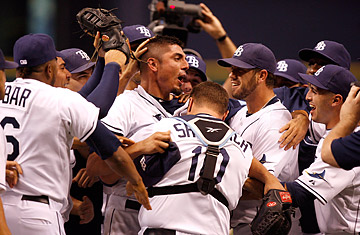
Tampa Bay Rays pitcher Matt Garza is mobbed by his teammates as he celebrates a no-hitter, the first in Rays history
If you're one of those baseball fans who loves a good slugfest, condolences; it hasn't been a great year. Baseball is entering the pennant-race season in the midst of an offensive drought. Start with the freakish number of no-hitters pitchers have tossed this year. There have been five official ones to date, the latest thrown by Matt Garza of the Tampa Bay Rays, who blanked the Detroit Tigers 5-0 on July 26. Let's also count a sixth: the perfect game that umpire Jim Joyce stole from Detroit's Armando Galarraga with a bad call back in early June. The last year baseball saw six no-hitters by the end of July was 1917. The last time three perfect games (Oakland's Dallas Braden and Philadelphia's Roy Halladay threw the official ones) were thrown in one season? Never.
These gems, however, are statistical anomalies. In baseball, the difference between a no-hitter and a one-hitter or even a two-hitter is just a bad bounce here, a fluke hit there. The pitchers were bound to break through en masse one year and deliver a flood of no-nos. "Random clusters of events occur in nature," says Bill James, the patriarch of advanced statistical analysis in baseball, who is now a consultant for the Boston Red Sox. "I think this is one."
What's more telling is the increasing frequency with which teams are eking out only a couple of hits a game. According to FanGraphs, a baseball-statistics website, teams have registered two hits or fewer in a game on 45 occasions through July 29 this season. That's more than double the number of such games witnessed through July of the 1999 season, when baseball was at the apex of the so-called steroid era and run production was near a 20-year high.
The shift in baseball's balance of power over the past decade, from the sluggers at the plate to the pitchers on the mound, has been startling. According to FanGraphs, teams have averaged 4.94 runs per nine innings this season, down 15% from 2000 and the lowest level since 1992. Hits are also lower than they've been in 18 years. Teams are smacking 0.96 home runs per nine innings, a 24% drop from 10 years ago and the lowest rate since 1993. Only four players have hit 25 or more home runs this season. Just one, Jose Bautista of the Toronto Blue Jays, has reached 30. "That's just startling," says Fred Claire, former general manager of the Los Angeles Dodgers.
Meanwhile, pitchers are averaging 7.03 strikeouts per game, which is an all-time high, according to FanGraphs. Some are stringing together memorable seasons. For example, Ubaldo Jimenez of the Colorado Rockies, whose home field in mile-high Denver is no pitcher's paradise, has a 16-2 record and a 2.67 ERA. (Jimenez also tossed one of those six no-hitters earlier this year.) If Florida's Josh Johnson were to end the season with the 1.72 ERA he's currently sporting, he would turn in the lowest mark since Greg Maddux's 1.63 ERA in 1995. Sports Illustrated recently dubbed 2010 a "Year of the Pitcher."
So what's causing the power shift to the pitchers? The discussion always starts with steroids. Improved drug testing has certainly played a role in declining offensive stats. It's safe to assume that fewer players are juiced now than in the late 1990s and early 2000s. Anecdotally, hulking caricatures like Barry Bonds seem a rarer life form.
However, since baseball still can't test for HGH, a performance enhancer undetectable in a urine sample, don't bank that hitters are completely clean. "We really don't know anything for sure," notes David Cameron, a former accountant and economics major who is now managing editor of FanGraphs. Further, many pitchers were also caught using steroids — wouldn't that at least partially cancel out the advantage for hitters?
Some people inside baseball wonder if more shadowy forces are at play. "Call me a conspiracy theorist, but I still believe the ball was juiced in the mid-to-late 1990s," says future Hall of Fame pitcher Tom Glavine, who retired this year after a 22-season career that spanned the steroid and poststeroid eras. "I don't care what anybody says — those things were like a golf ball in your hand," says Glavine. "They were so tightly wound." Glavine insists the ball softened up during the waning years of his career.
James points to the bats. "The leagues may be doing something with bats that they're not really talking about," he says. "One of the main causes of the hitting explosion of 2000-2005 was bat design — very thin handles, machine-compressed wood and multiple coats of shellac creating a very, very hard-surface bat. I know that I have seen fewer shattered bats this year than I have seen in 15 years." Major League Baseball denies tinkering with any equipment. "We regularly have done studies on balls and bats," says MLB spokesman Patrick Courtney, "and go through quality-control checks to ensure there are no differences."
